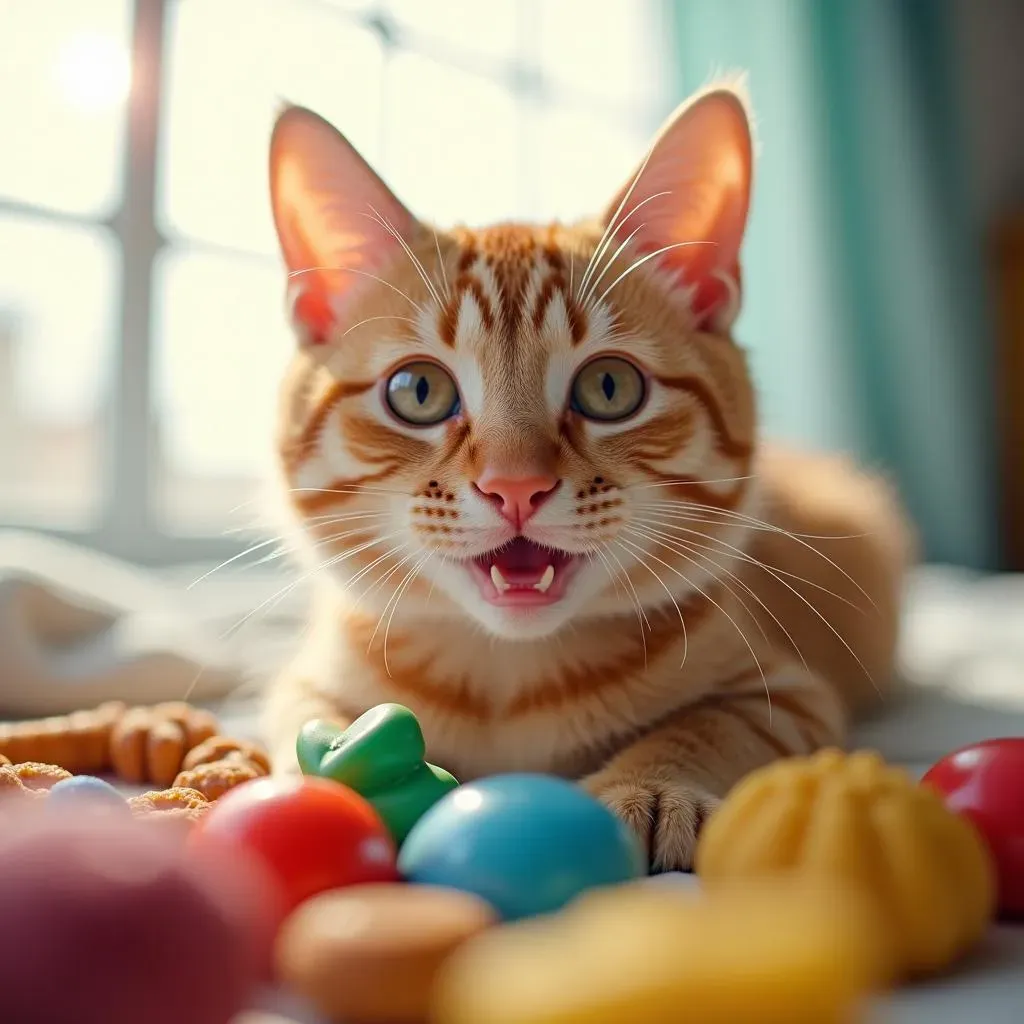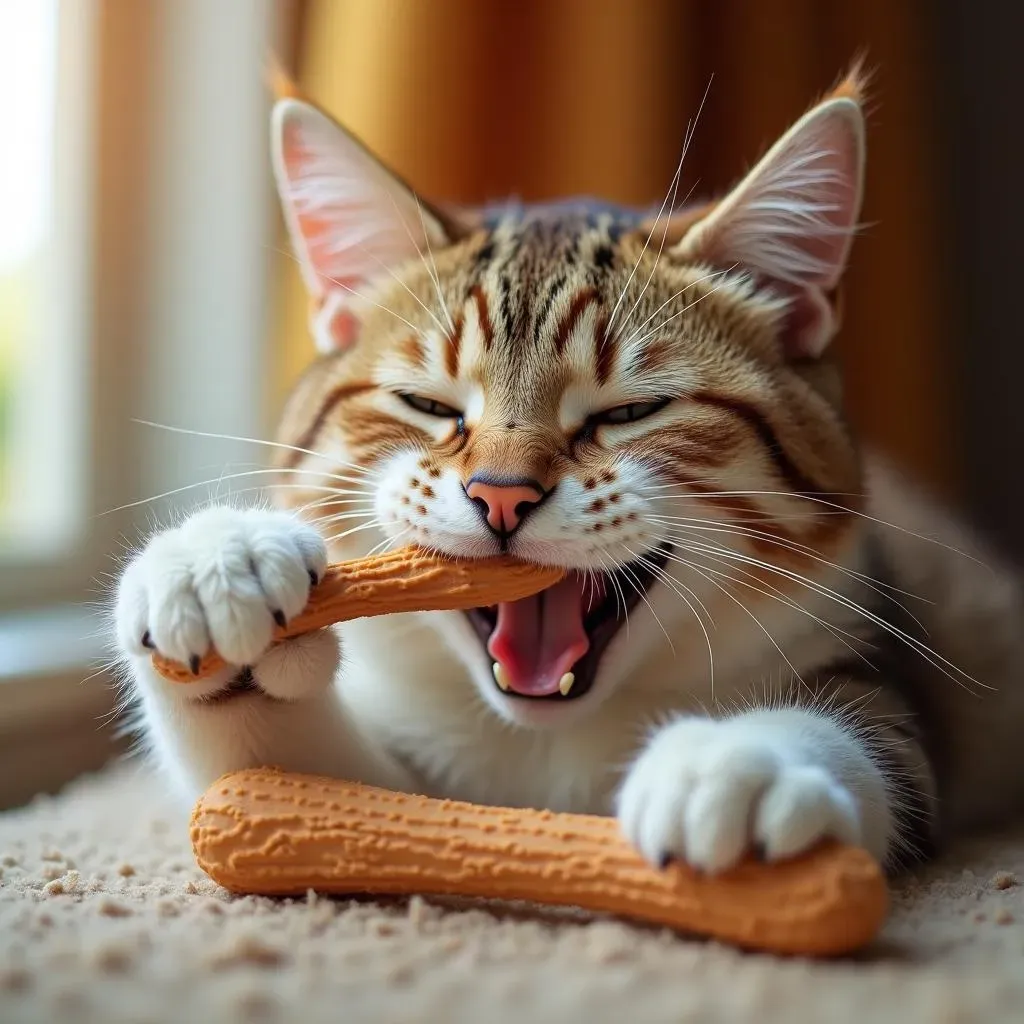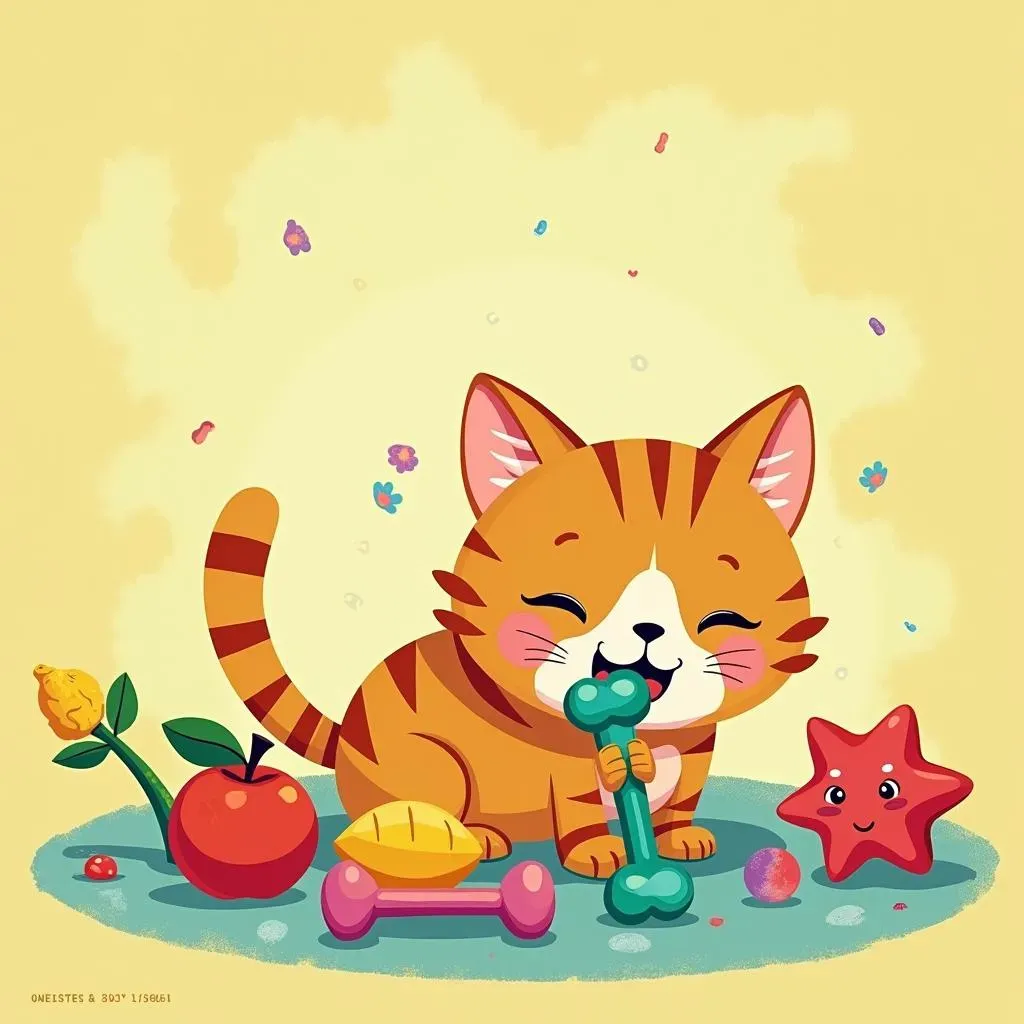Table of Contents
Ever wonder, "Do cats need chew toys?" While dogs might be the first animals that come to mind when you think of chew toys, our feline friends can benefit from them too. Cats explore the world with their mouths, and chewing is a natural behavior that serves several purposes. This article will dive into the world of cat chew toys, exploring whether they're a necessity or a luxury for your furry companion. We'll uncover the reasons why cats chew, from teething kittens to adult cats with specific needs. You'll discover how the right chew toy can satisfy your cat's hunting instincts, promote dental health, and even alleviate boredom. We'll also guide you through selecting safe and engaging chew toys, helping you make the best choice for your cat's individual preferences and needs. So, are you ready to unravel the mystery of cat chew toys? Let's get started!
Why Cats Chew: Understanding the Instinct

Why Cats Chew: Understanding the Instinct
The Natural Urge to Hunt and Explore
Cats are natural hunters, and chewing is an integral part of their predatory behavior. In the wild, cats use their teeth to catch, kill, and consume prey. Even domesticated cats retain this instinct, and chewing provides a way for them to satisfy their innate drive to hunt. When a cat chews, it's not just about gnawing on something; it's about engaging with the world in a way that feels natural and fulfilling. This behavior helps cats explore textures, tastes, and objects, enriching their environment and preventing boredom.
Teething and Jaw Development
Just like human babies, kittens go through a teething phase. As their adult teeth emerge, their gums can become sore and irritated. Chewing provides relief by massaging the gums and helping the new teeth break through. Providing appropriate chew toys during this stage can prevent kittens from targeting furniture, electrical cords, or other inappropriate items. Moreover, chewing helps strengthen the jaw muscles, contributing to healthy oral development.
Alleviating Stress and Anxiety
Chewing can also serve as a coping mechanism for cats experiencing stress or anxiety. The repetitive motion of chewing can be calming and help release pent-up energy. Cats may chew more when they're feeling insecure, bored, or frustrated. By providing chew toys, you can offer a safe and healthy outlet for these emotions. It's important to identify and address the underlying causes of stress, but chew toys can be a valuable tool in managing anxiety in cats.
- Chewing satisfies hunting instincts.
- Chewing soothes teething pain in kittens.
- Chewing reduces stress and anxiety.
Do Cats Need Chew Toys? Benefits and Considerations

Do Cats Need Chew Toys? Benefits and Considerations
Enrichment and Mental Stimulation
While do cats need chew toys may not be as crucial as they are for dogs, they offer significant enrichment and mental stimulation. Indoor cats, in particular, can benefit from the opportunity to engage in natural chewing behaviors. Providing chew toys can help prevent boredom, reduce destructive behaviors, and improve overall well-being. When cats have appropriate outlets for their energy, they are less likely to develop behavioral issues related to frustration or inactivity.
Think of it this way: a chew toy is like a puzzle for your cat's mouth. It challenges them, keeps them entertained, and provides a sense of accomplishment. Plus, it's a lot more appealing than your favorite pair of shoes!
Dental Health Benefits
One of the key benefits of chew toys for cats is their contribution to dental health. Chewing helps to remove plaque and tartar buildup, reducing the risk of dental disease. Some chew toys are specifically designed with textured surfaces or infused with cat-friendly dental cleaning agents to enhance their effectiveness. Regular chewing can act as a natural toothbrush, promoting healthier gums and fresher breath. While chew toys are not a substitute for professional dental cleanings, they can be a valuable addition to your cat's oral hygiene routine.
For example, I once had a cat named Whiskers who was prone to dental issues. After introducing dental chew toys, I noticed a significant improvement in his gum health and breath. It was a simple way to make a big difference in his overall well-being.
Redirecting Inappropriate Chewing
If your cat has a habit of chewing on furniture, electrical cords, or other inappropriate items, chew toys can be a lifesaver. By providing appealing and safe alternatives, you can redirect your cat's chewing behavior to more acceptable outlets. It's important to choose chew toys that are durable and free of small parts that could be ingested. Experiment with different textures, shapes, and flavors to find what your cat enjoys most. Consistency is key; always offer the chew toy when you see your cat chewing on something they shouldn't.
It's all about offering a better option. If your cat loves the texture of cardboard, try a cardboard chew toy. If they're drawn to soft materials, look for plush toys designed for chewing. The goal is to make the chew toy more enticing than the forbidden object.
Benefit | Description |
|---|---|
Mental Stimulation | Prevents boredom and encourages natural behaviors. |
Dental Health | Reduces plaque and tartar buildup, promoting healthy gums. |
Behavioral Redirection | Redirects chewing away from inappropriate items. |
Kitten Teething and Chew Toys: A MustHave?

Kitten Teething and Chew Toys: A MustHave?
Why Teething Kittens Need Chew Toys
When it comes to kitten teething and chew toys, think of it as providing relief during a particularly itchy and uncomfortable time. Just like human babies, kittens experience discomfort as their adult teeth push through their gums. This process typically begins around 3-4 months of age and can last for several months. During this time, kittens have a strong urge to chew on anything and everything they can get their tiny paws on. This isn't just about exploration; it's about finding relief from the pain and pressure in their gums.
Providing appropriate chew toys is essential for several reasons. First, it offers a safe and acceptable outlet for their chewing instincts. Second, the act of chewing can help to massage their gums and alleviate discomfort. Finally, it can prevent them from targeting your furniture, electrical cords, or other potentially dangerous items. Trust me, a strategically placed chew toy can save your favorite chair from becoming a teething victim!
Choosing the Right Chew Toys for Teething Kittens
Selecting the right chew toys for teething kittens is crucial for their safety and enjoyment. Look for toys that are specifically designed for kittens and made from soft, pliable materials. Avoid toys with small parts that could be chewed off and ingested, as these can pose a choking hazard. Good options include soft rubber toys, plush toys with minimal stuffing, and even chilled toys that can provide extra soothing relief.
Introducing a variety of textures and shapes can also help keep your kitten engaged. Some kittens prefer to gnaw on smooth surfaces, while others enjoy the sensation of chewing on textured materials. Experiment with different options to find what your kitten likes best. Remember to supervise your kitten during playtime and inspect the toys regularly for any signs of damage. A little bit of prevention can go a long way in ensuring a safe and enjoyable teething experience for your furry friend.
Toy Type | Material | Benefits | Cautions |
|---|---|---|---|
Soft Rubber Toys | Pliable rubber | Durable, easy to clean, massages gums | Check for small parts, avoid overly hard rubber |
Plush Toys | Soft fabric, minimal stuffing | Comforting, gentle on gums | Supervise playtime, check for loose seams |
Chilled Toys | Water-filled, freezable | Provides soothing relief for sore gums | Ensure toy is durable and won't leak |
Chew Toys for Dental Health: Keeping Kitty's Teeth Clean

Chew Toys for Dental Health: Keeping Kitty's Teeth Clean
The Importance of Dental Health for Cats
Chew toys for dental health aren't just about fun and games; they're a crucial part of your cat's overall well-being. Dental disease is incredibly common in cats, affecting a significant percentage of felines by the time they reach middle age. This can lead to a whole host of problems, from bad breath and painful gums to more serious health issues like heart and kidney disease. Regular dental care is essential to prevent these problems and keep your kitty feeling their best. While brushing your cat's teeth is the gold standard, it's not always feasible for every cat owner. That's where dental chew toys come in – they offer a practical and enjoyable way to support your cat's oral hygiene between professional cleanings.
How Chew Toys Clean Teeth
So, how exactly do chew toys help keep your cat's teeth clean? The act of chewing itself helps to scrape away plaque and tartar buildup, reducing the risk of dental disease. Some chew toys are specifically designed with textured surfaces or infused with cat-friendly dental cleaning agents to enhance their effectiveness. These features help to massage the gums, stimulate saliva production, and remove debris from hard-to-reach areas. Think of it as a mini teeth-cleaning session every time your cat enjoys a chew toy. It's not a replacement for professional dental care, but it's a valuable addition to your cat's oral hygiene routine.
Choosing the Right Dental Chew Toys
When selecting dental chew toys for your cat, it's essential to choose options that are safe, durable, and appealing. Look for toys made from non-toxic materials that are designed to withstand vigorous chewing. Avoid toys with small parts that could be chewed off and ingested. Consider the size and shape of the toy, ensuring it's appropriate for your cat's mouth. Opt for toys with textured surfaces, such as ridges or nubs, to maximize their cleaning effectiveness. You can also find chew toys infused with cat-friendly dental cleaning agents like enzymes or mint to further promote oral hygiene. Experiment with different options to find what your cat enjoys most, and remember to supervise their playtime to ensure their safety.
Feature | Benefit |
|---|---|
Textured Surfaces | Scrape away plaque and tartar buildup |
Durable Materials | Withstand vigorous chewing |
Cat-Friendly Flavors | Increase appeal and promote chewing |
Choosing the Best Chew Toys for Your Cat: Safety and Preferences

Choosing the Best Chew Toys for Your Cat: Safety and Preferences
Prioritizing Safety: Materials and Construction
When choosing the best chew toys for your cat, safety should always be your top priority. Start by carefully examining the materials used to make the toy. Opt for non-toxic, durable materials that are designed to withstand chewing. Avoid toys made from cheap plastics or materials that could easily break apart into small pieces. Look for toys that are specifically labeled as "cat-safe" or "non-toxic." The construction of the toy is also crucial. Check for any small parts, such as buttons, ribbons, or bells, that could be chewed off and ingested. These can pose a choking hazard or cause intestinal blockages. Seams should be securely stitched, and any glued-on components should be firmly attached. Remember, it's always better to err on the side of caution when it comes to your cat's safety.
Understanding Your Cat's Preferences
Every cat has their own unique preferences when it comes to chew toys. Some cats prefer soft and plush toys, while others prefer hard and textured surfaces. Some cats are drawn to toys with catnip, while others couldn't care less. Pay attention to your cat's play style and chewing habits to get a sense of what they might enjoy. Do they like to gnaw, bat, or carry their toys around? Do they prefer to play alone or interact with you? Experiment with different types of chew toys to see what piques their interest. You can also try offering toys with different textures, shapes, and sizes. Once you find a few winners, you can stock up on those and rotate them to keep your cat engaged. Remember, it's all about finding what makes your cat happy and satisfied.
Types of Chew Toys to Consider
There's a wide variety of chew toys available for cats, so you're sure to find something that suits your feline friend's preferences. Here are a few popular options to consider:
- Dental Chew Toys: These toys are designed with textured surfaces to help clean your cat's teeth as they chew.
- Catnip Toys: Many cats are attracted to catnip, so a catnip-filled chew toy can be a great way to encourage chewing.
- Puzzle Toys: These toys challenge your cat to work for their reward, providing mental stimulation and encouraging chewing.
- Soft Plush Toys: Some cats enjoy chewing on soft and cuddly toys, especially those with minimal stuffing.
- Rubber Toys: Durable rubber toys can withstand vigorous chewing and provide a satisfying gnawing experience.
Remember to supervise your cat while they are playing with any new toy to ensure their safety.
Toy Type | Material | Benefits | Considerations |
|---|---|---|---|
Dental Chew Toys | Rubber, plastic | Promotes dental health | Check for durability and non-toxicity |
Catnip Toys | Fabric, stuffing, catnip | Entices chewing, provides enrichment | Monitor for excessive catnip consumption |
Puzzle Toys | Plastic, wood | Stimulates mental activity, encourages chewing | Choose appropriate difficulty level |
Conclusion: Chew Toys – A Benefit, Not Always a Need
So, do cats need chew toys? The answer isn't a simple yes or no. While not every cat requires chew toys, they offer a range of benefits, from dental care to mental stimulation. Understanding your cat's individual needs and preferences is key to determining if chew toys are a worthwhile addition to their toy collection. Whether you have a teething kitten, a bored indoor cat, or a feline with a penchant for chewing on inappropriate items, exploring the world of cat chew toys can lead to a happier, healthier, and more entertained companion. Just remember to prioritize safety and supervision to ensure your kitty's chewing experience is a positive one.